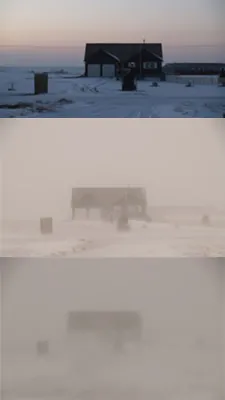Blizzards

Blowing snow during a blizzard reduces visibility.
NOAA National Weather Service images by Ben Jacquot
Snow whirling around in wind blowing faster than highway speed limits makes the whole world look white. Imagine snow so deep that second graders can’t see over the top of it. The wind and the snow may cause a power outage and collapse roofs. That’s what you can expect from a blizzard.
What Is a Blizzard?
The National Weather Service defines a blizzard as a storm with large amounts of snow or blowing snow, winds greater than 35 mph (56 kph), and visibility of less than ¼ mile (0.4 km) for at least three hours. Some blizzards, called ground blizzards, have no falling snow. Instead, snow that had fallen before the blizzard is blown around or drifts in a way to create these conditions.
Blizzard conditions usually build up on the northwest side of a powerful storm system. The storm produces ample snow while strong winds develop because of a difference in pressure between the low pressure of the storm and the high pressure beyond the storm.
Conditions during a blizzard can be severe. Travel becomes dangerous when the blowing snow causes whiteout conditions and sky and ground look white. Roads can be partially or fully blocked by snowdrifts – piles of snow formed by the wind. Many times cold temperatures that can cause frostbite or hypothermia are part of a blizzard and can last for days after the storm has ended.
Where Do Blizzards Occur?
In the United States, blizzards are common in the upper Midwest and the Great Plains but occur in most areas of the country except for the Gulf Coast and the California coast. Blizzards can occur all over the world, even in the tropics where it is cold on high altitude mountaintops.
What a Blizzard Needs
Three things are needed to make a large snowstorm or blizzard:
1. Cold air (below freezing) is needed to make snow.
For snow to fall to the ground, the temperature must be cold both up in the clouds where snowflakes form and down at ground level. If the air near ground level is too warm, the snow will melt on its way down, changing to rain or freezing rain.
2. Moisture is needed to form clouds and precipitation.
Moisture in the air is called water vapor. Air blowing across a body of water, such as a large lake or the ocean, is an excellent source of water vapor. As wind moves air over the water, some water evaporates from the surface, putting vapor into the air. This is how lake effect snowstorms and nor’easters pick up so much moisture. However, cold air is not able to hold much water vapor. In fact, very cold air does not make very much snow.
3. Moist air needs to rise over very cold air, making clouds and snow.
There are two ways that moist air might rise over cold air. Winds pull cold air toward the equator from the poles and bring warmer, moist air toward the poles from the equator. When warm air and cold air are brought together, a front is formed and snow can form. Warm air can also rise to form clouds and blizzard snows as it flows up a mountainside.